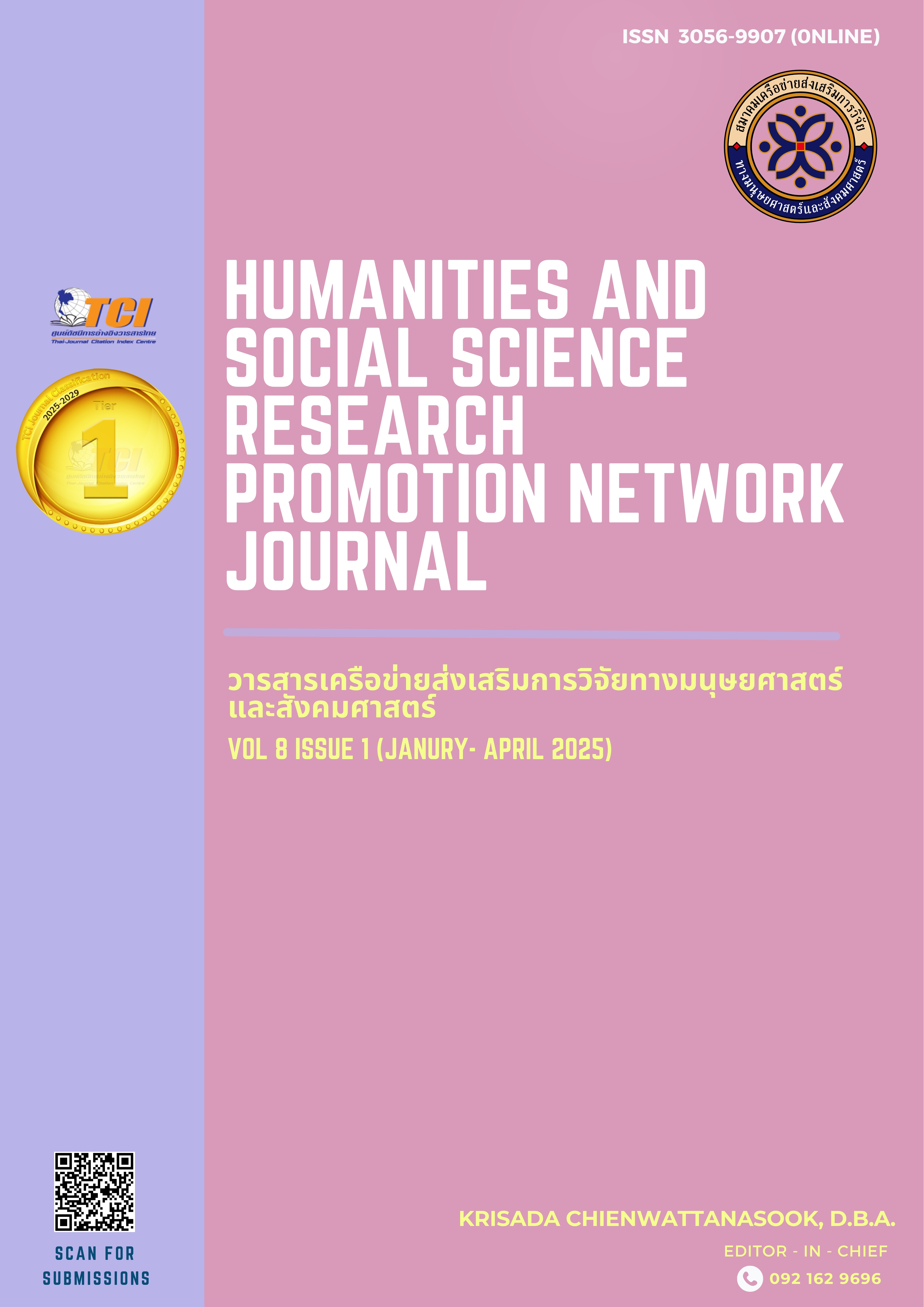การบริหารต้นทุนเชิงกลยุทธ์กับการสร้างความได้เปรียบทางการแข่งขัน อย่างยั่งยืนของผู้ประกอบการในประเทศไทย
คำสำคัญ:
บริหารต้นทุนเชิงกลยุทธ์ , ความได้เปรียบทางการแข่งขัน , ความยั่งยืน , ผู้ประกอบการ , การลดต้นทุน, การสร้างมูลค่าบทคัดย่อ
การบริหารต้นทุนเชิงกลยุทธ์เป็นกระบวนการที่สำคัญในการเพิ่มขีดความสามารถในการแข่งขันขององค์กรในระยะยาว โดยเฉพาะอย่างยิ่งสำหรับผู้ประกอบการในประเทศไทยที่ต้องเผชิญกับการแข่งขันที่ทวีความรุนแรงในตลาดโลก บทความนี้มีวัตถุประสงค์เพื่อศึกษาวิธีการบริหารต้นทุนเชิงกลยุทธ์เพื่อสร้างความได้เปรียบทางการแข่งขันอย่างยั่งยืนในบริบทของผู้ประกอบการไทย แนวคิดสำคัญที่กล่าวถึงประกอบด้วย การใช้เครื่องมือการบริหารต้นทุน เช่น การคำนวณต้นทุนตามกิจกรรม การวิเคราะห์ห่วงโซ่คุณค่า และการจัดการต้นทุนตลอดวงจรชีวิตผลิตภัณฑ์ เพื่อลดต้นทุนการดำเนินงานและเพิ่มมูลค่าของสินค้าและบริการ นอกจากนี้ บทความยังได้วิเคราะห์ตัวอย่างกรณีศึกษาของผู้ประกอบการในอุตสาหกรรมต่าง ๆ เพื่อแสดงให้เห็นว่าการบริหารต้นทุนเชิงกลยุทธ์ช่วยเสริมสร้างความยั่งยืนในธุรกิจ และทำให้ผู้ประกอบการสามารถรักษาความสามารถในการแข่งขันได้อย่างมีประสิทธิภาพ บทความสรุปว่าการบริหารต้นทุนเชิงกลยุทธ์เป็นกลยุทธ์ที่สำคัญที่ช่วยให้องค์กรสามารถตอบสนองต่อการเปลี่ยนแปลงของตลาด ลดความเสี่ยง และเพิ่มโอกาสในการเติบโตอย่างยั่งยืน
เอกสารอ้างอิง
กษมาพร ลาผ่าน, สุวรรณ หวังเจริญเดช และ นาถนภา นิลนิยม. (2563). ผลกระทบของการบริหารต้นทุนคุณภาพที่มีต่อความได้เปรียบทางการแข่งขันของธุรกิจเครื่องใช้ไฟฟ้าและอิเล็กทรอนิกส์ในประเทศไทย. วารสารการบัญชีและการจัดการ, 12(1), 31-41.
กัญฐณา ดิษฐ์แก้ว. (2566). การบริหารต้นทุนเชิงกลยุทธ์ (Strategic Cost Management). สำนักพิมพ์มหาวิทยาลัยธรรมศาสตร์.
ไกรฤกษ์ เป็นแก้ว. (2548). การสร้างความได้เปรียบในการแข่งขันแบบยั่งยืนสำหรับธุรกิจบริการ. วารสารนักบริหาร, 25(4), 20-24.
ประภาศรี อมรสิน. (2548). การแข่งขันทางธุรกิจ. วารสารนักบริหาร, 25(2), 37-42.
ฟ้าใหม่ ห่อทรัพย์ และธีรา เอราวัณ. (2563). ความสัมพันธ์ระหว่างกลยุทธ์การจัดการการบริการกับความได้เปรียบทางการแข่งขันของธุรกิจโรงพยาบาลเอกชนในประเทศไทย. วารสารการบัญชีและการจัดการ มหาวิทยาลัยมหาสารคาม, 12(1), 180-191.
วรางกูร อิศรางกูร ณ อยุธยา และฉัตรชัย ราคา. (2562). การสร้างความได้เปรียบในการแข่งขันประสิทธิภาพและกระบวนการที่มีผลต่อLean Six Sigma (กรณีศึกษาอุตสาหกรรมยานยนต์ภายในประเทศไทย). วารสารวิชาการ มหาวิทยาลัยกรุงเทพธนบุรี, 8(1), 144-160.
วิจัยกรุงศรี. (2567). แนวโน้มธุรกิจและอุตสาหกรรมไทยปี 2567-2569: ปัจจัยแวดล้อมทางเศรษฐกิจมหภาค. https://thaitara.org/wp-content/uploads/2024/02/SO_Industry_Outlook_2024_2026_240109_TH_EX_BAY.pdf
ศศิประภา ชัยประสิทธิ์. (2548). กลยุทธ์การสร้างความได้เปรียบทางการแข่งขันในเศรษฐกิจยุคใหม่. วารสารนักบริหาร, 25(2), 43-49.
อรวรรณ แซ่ว่าง. (2563). ทุนทางสังคมกับความเข้มแข็งทางเศรษฐกิจของชุมชนย่านเยาวราช. วารสารพัฒนาสังคม, 22(2), 95-105.
Anderson, S., & Dekker, H. (2014). From make-or-buy to coordinating collaboration: Management Control in Strategic Alliances. Management Control and Uncertainty (pp. 47-68). Palgrave Macmillan.
Barney, J. B. (1991). Firm resources and sustainable competitive advantage. Journal of Management, 17, 99-120. https://doi.org/10.1177/014920639101700108
Diefenbach, U., Wald, A., & Gleich, R. (2018). Between cost and benefit: Investigating effects of cost management control systems on cost efficiency and organisational performance. Journal of Management Control, 29, 63-89. https://doi.org/10.1007/s00187-018-0261-5
Ding, H., Zhou, D. Q., Liu, G. Q., & Zhou, P. (2020). Cost reduction or electricity penetration: Government R&D-induced PV development and future policy schemes. Renewable and Sustainable Energy Reviews, 124, 109752. https://doi.org/10.1016/j.rser.2020.109752
Ditkaew, K. (2018, August). The effects of cost management quality on the effectiveness of internal control and reliable decision-making: evidence from Thai industrial firms. In Proceedings of the 10th International RAIS Conference on Social Sciences and Humanities (pp. 60-69). Scientia Moralitas Research Institute. https://doi.org/10.2991/rais-18.2018.10
Doncheva, D., & Stoyancheva, D. (2021). Cost and profit efficiency: the case of Bulgarian hotel industry. Eastern Journal of European Studies, 12(2), 190-212. https://doi.org/10.47743/ejes-2021-0210
Drury, C., & Tayles, M. (2017). Management and cost accounting. Cengage Learning EMEA.
Forsman, S. (2004). How do small rural food-processing firms compete? A resource-based approach to competitive strategies. MTT Agrifood Research Finland.
Ghorbanpour, A., & Azimi, Z. N. (2022). Application of green supply chain management in the oil industries: modeling and performance analysis. Materials Today: Proceedings, 49, 542-553. https://doi.org/10.1016/j.matpr.2021.03.672
Hafeez, K., & Essmail, E. A. (2007). Evaluating organisation core competences and associated personal competencies using analytical hierarchy process. Management research news, 30(8), 530-547. https://doi.org/10.1108/01409170710773689
Hill, C. W. L., & Jones, G. R. (1995). Strategic Management Theory. An Integrated Approach (3rd ed.). Houghton Mifflin company.
Hrovatin, N., Cagno, E., Dolšak, J., & Zorić, J. (2021). How important are perceived barriers and drivers versus other contextual factors for the adoption of energy efficiency measures: An empirical investigation in manufacturing SMEs. Journal of Cleaner Production, 323, 129123. https://doi.org/10.1016/j.jclepro.2021.129123
Jayabalan, J., Raman, M., Dorasamy, M., & Ching, N. K. C. (2009). Outsourcing of accounting functions amongst SME companies in Malaysia: An exploratory study. Accountancy Business and the Public Interest, 8(2), 96-114.
Kamyabi, Y., & Devi, S. (2011). Accounting outsourcing and firm performance in Iranian SMEs. International Journal of Economics and Finance, 3(4), 181–193. https://doi.org/10.5539/ijef.v3n4p181
Kaplan, R. S., & Norton, D. P. (2015). Balanced Scorecard Success: The Kaplan-Norton Collection (4 Books). Harvard Business Review Press.
Kostrzewa-Nowak, D., & Gos, W. (2023). Practical applications of target costing in a multidisciplinary R&D project. Sustainability, 15(1), 124. https://doi.org/10.3390/su15010124
Le, T., & Nguyen, T. (2019). Practice environmental cost management accounting: The case of Vietnamese brick production companies. Management Science Letters, 9(1), 105-120. http://dx.doi.org/10.5267/j.msl.2018.10.012
Martin, C. E., & Jones, N. (2018). Nephrin signaling in the podocyte: an updated view of signal regulation at the slit diaphragm and beyond. Frontiers in Endocrinology, 9, 302. https://doi.org/10.3389/fendo.2018.00302
Mendes, L., & França, G. (2024). Lean thinking and risk management in healthcare organizations: a systematic literature review and research agenda. International Journal of Quality & Reliability Management. https://doi.org/10.1108/IJQRM-06-2023-0210
O’Brien, T. (2020). Has inclusion become a barrier to inclusion?. Support for Learning, 35(3), 298-311. https://doi.org/10.1111/1467-9604.12311
Porter, M. E. (1985). Competitive Advantage: Creating and Sustaining Superior Performance. The Free Press.
Rahman, N. A., & Ramli, A. (2014). Entrepreneurship management, competitive advantage and firm performances in the craft industry: concepts and framework. Procedia-Social and Behavioral Sciences, 145, 129-137. https://doi.org/10.1016/j.sbspro.2014.06.019
Relich, M., Bocewicz, G., & Banaszak, Z. (2021, August). Cost projections for the product life cycle at the early stages of product development. In IFIP International Conference on Advances in Production Management Systems (pp. 437-446). Springer International Publishing. https://dx.doi.org/10.1007/978-3-030-85910-7_46
Roffia, P., Benavides, M. M., & Carrilero, A. (2024). Cost accounting practices in SMEs: liability of age and other factors that hinder or burst its implementation in turbulent years. International Entrepreneurship and Management Journal, 20(1), 115-139. https://doi.org/10.1007/s11365-023-00938-2
Ryan, V. (2024, March). Cost Management a High Priority in 2024. Corporate Finance. https://www.cfo.com/news/cost-management-2024-cost-cuts-supply-chain-procurement-sourcing-shifting-demand-leadership/709314/
Schuhmacher, A., Gassmann, O., & Hinder, M. (2016). Changing R&D models in research-based pharmaceutical companies. Journal of translational medicine, 14, 1-11. https://doi.org/10.1186/s12967-016-0838-4
Smith, J. Q., Jones, M. R., & Brown, C. D. (2020). Advancing Managerial Evolution and Resource Management in Contemporary Business Landscapes. Journal of Management Studies, 58, 1-25.
Suarez-Barraza, M. F., Miguel-Dávila, J. A., & Morales Contreras, M. F. (2022). KAIZEN: An ancestral strategy for operational improvement: literature review and trends. In International Scientific-Technical Conference MANUFACTURING (pp. 154-168). Springer. https://doi.org/10.1007/978-3-031-00218-2_13
Syafrudin, M., Alfian, G., Fitriyani, N. L., & Rhee, J. (2018). Performance analysis of IoT-based sensor, big data processing, and machine learning model for real-time monitoring system in automotive manufacturing. Sensors, 18(9), 2946. https://doi.org/10.3390/s18092946
Vanichchinchai, A. (2019). The effect of lean manufacturing on a supply chain relationship and performance. Sustainability, 11(20), 5751. https://doi.org/10.3390/su11205751
Wernerfelt, B. (1984). A resource-base view of the firm. Strategic Management Journal, 5(2), 171-180.
Zollo, M., & Winter S. G. (2002). Deliberate learning and the evolution of dynamic capabilities. Organization Science, 13(3), 339-353. https://doi.org/10.1287/orsc.13.3.339.2780
ดาวน์โหลด
เผยแพร่แล้ว
รูปแบบการอ้างอิง
ฉบับ
ประเภทบทความ
สัญญาอนุญาต
ลิขสิทธิ์ (c) 2025 กัญฐณา ดิษฐ์แก้ว, อโนทัย พลภาณุมาศ

อนุญาตภายใต้เงื่อนไข Creative Commons Attribution-NonCommercial-NoDerivatives 4.0 International License.
บทความที่ได้รับการตีพิมพ์เป็นลิขสิทธิ์ของ ผู้เขียน
ทัศนะและความคิดเห็นที่ปรากฏในบทความในวารสารเครือข่ายส่งเสริมการวิจัยทางมนุษยศาสตร์และสังคมศาสตร์จะถือเป็นความรับผิดชอบของผู้เขียนบทความนั้น และไม่ถือเป็นทัศนะและความรับผิดชอบของกองบรรณาธิการ








